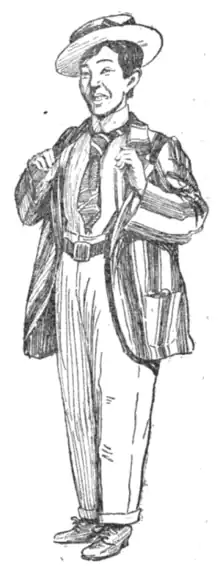Ritsuko Mori | |
|---|---|
森律子 | |
 Ritsuko Mori as sketched by Elizabeth Keith, from a 1918 publication | |
| Born | 30 October 1890 Tokyo |
| Died | 22 July 1961 |
| Occupation | Actress |
Ritsuko Mori (30 October 1890 – 22 July 1961) (森律子 in Japanese, or もり りつこ in kana) was a Japanese actress. As a woman from a respected family, her entry into the acting profession was considered disreputable, but her success improved the opportunities and social standing of professional actresses in Japan.
Early life
Mori was born in Tokyo, the daughter of Hajime Mori, a lawyer and politician.[1] She graduated from Atomi Girls' School.[2] She was one of the first students trained as an actress with Sada Yacco, at the Imperial Training School for Actresses.[3][4] She toured in Europe to study Western theatre in 1913.[5][6]
Career
Mori's choice of an acting career was considered a shocking embarrassment to her family and social circles.[7][8][9] "All my relatives and friends were against it and even persecuted me," she explained in 1919.[1] Her success improved the social standing of Japanese women working in the theatre.[10] She was inspired by many performers who went before her, including male Peking opera star Mei Lanfang.[11]
Mori appeared in stage comedies,[12] dramas,[13] kabuki,[14] and operettas.[15] In 1916, she played a blind heroine character in a one-act tragedy, Mitsu-no-Kokoro, at the Imperial Theatre.[13] A Western reviewer described her "interesting" performance in a breeches role in 1918, saying Mori "gets full play for her vivacity and skill."[15] Also in 1918, she played Portia in an adaptation of Shakespeare's The Merchant of Venice by Yuzo Tsubouchi.[16] In 1919 she gave a eulogy speech at the funeral of her colleague, actress Sumako Matsui; "Why must you leave us, the actresses of Japan, struggling hard for the perfection of woman's part upon the stage, new to the Japanese public and most difficult for us?"[17]
Mori was "the leading lady of the Imperial Theatre" and helped with managing the theatre's productions in the 1920s,[2] according to American journalist Marguerite Harrison.[18] She officially welcomed Irish tenor John McCormack on his arrival in Tokyo in 1926.[19] In the 1930s she worked with actor Shotaro Hanayagi.[20]
Personal life
She adopted her niece, actress Kakuko Mori. She died in 1961, at the age of 70.
References
- 1 2 Wilds, Edith (April 1919). "Ritsuko Mori, Star and Pioneer". Everybody's Magazine. 40 (4): 45.
- 1 2 DeForest, Charlotte Burgis (1923). The Woman and the Leaven in Japan. Central Committee on the United Study of Foreign Missions. pp. 143–144.
- ↑ Downer, Lesley (2003). Madame Sadayakko: The Geisha who Bewitched the West. Penguin. p. 288. ISBN 978-1-59240-050-8.
- ↑ Darby, Trudi; Roberts, Jane (2017-08-21). English Without Boundaries: Reading English from China to Canada. Cambridge Scholars Publishing. p. 50. ISBN 978-1-5275-0058-7.
- ↑ Faust, Allen Klein (1926). The New Japanese Womanhood. George H. Doran. p. 93.
- ↑ "Farewell to Miss Mori". Japan Times. March 22, 1913. p. 1141.
- ↑ Sewell, Jan; Smout, Clare (2020-04-29). The Palgrave Handbook of the History of Women on Stage. Springer Nature. p. 341. ISBN 978-3-030-23828-5.
- ↑ McKee, Rose (1936-11-25). "A New Deal for the Fair Sex in Japan's Show Business". The Orlando Sentinel. p. 3. Retrieved 2022-11-02 – via Newspapers.com.
- ↑ Kano, Ayako (2001). Acting like a woman in modern Japan : theater, gender, and nationalism. Internet Archive. New York : Palgrave. p. 74. ISBN 978-0-312-29291-1.
- ↑ Atwood, Elizabeth (2020-09-01). The Liberation of Marguerite Harrison: America's First Female Foreign Intelligence Agent. Naval Institute Press. ISBN 978-1-68247-530-0.
- ↑ Tian, M. (2012-01-02). Mei Lanfang and the Twentieth-Century International Stage: Chinese Theatre Placed and Displaced. Springer. ISBN 978-1-137-01043-8.
- ↑ "Japanese Take up the Task of Westernising Eastern Stage". The Philadelphia Inquirer. 1913-06-29. p. 14. Retrieved 2022-11-02 – via Newspapers.com.
- 1 2 "Suggestions of Coolness". The Herald of Asia. July 8, 1916. p. 492. Retrieved November 2, 2022.
- ↑ Isaka, Maki (2016-04-05). Onnagata: A Labyrinth of Gendering in Kabuki Theater. University of Washington Press. p. 128. ISBN 978-0-295-80624-2.
- 1 2 "Miss Ritsuko Mori". The New East. 2 (6): 621. June 1918.
- ↑ "Dr. Tsubouchi's Work". The Evening Post. March 16, 1918. p. 30. Retrieved November 2, 2022.
- ↑ "Japan Upset by Dying Wish of Famous Actress". The Courier-Journal. 1919-02-21. p. 6. Retrieved 2022-11-02 – via Newspapers.com.
- ↑ Harrison, Marguerite (1924). Red Bear Or Yellow Dragon. George H. Doran Company. pp. 44–47, quote on 44.
- ↑ "Tokio Welcomes Tenor". The Evening News. 1926-09-28. p. 8. Retrieved 2022-11-02 – via Newspapers.com.
- ↑ "Japan Following Hollywood in Modern Screen Devices". The Honolulu Advertiser. 1937-09-08. p. 2. Retrieved 2022-11-02 – via Newspapers.com.
External links
- A woodblock portrait of Ritsuko Mori by Yamamura Toyonari (1915), in the Lavenberg Collection of Japanese Prints at the University of Oregon; another print of this image is in the collection of the Honolulu Museum of Art